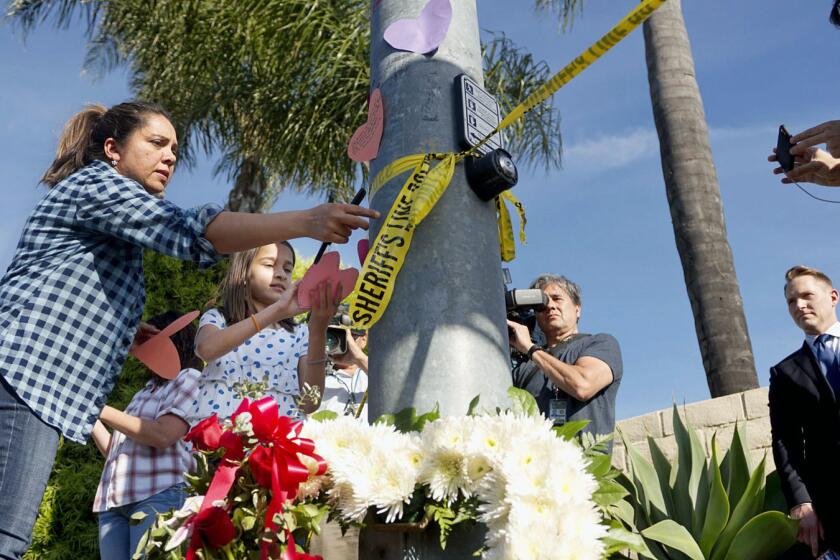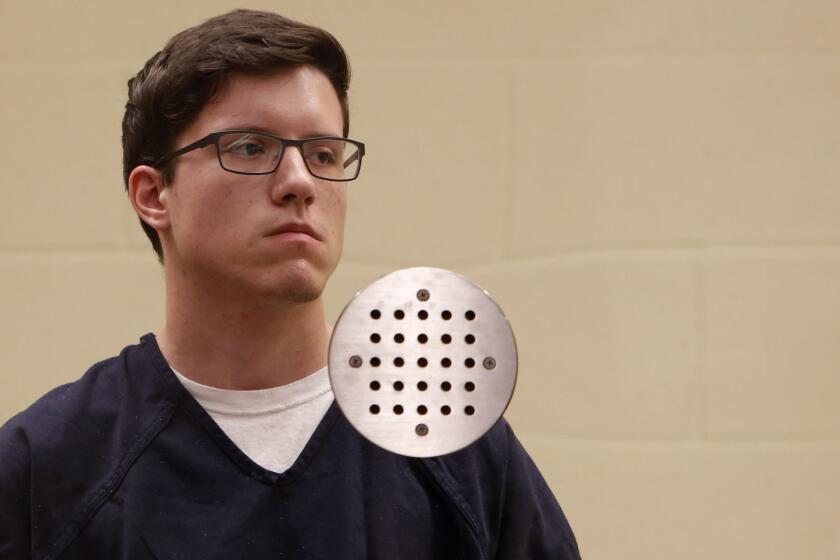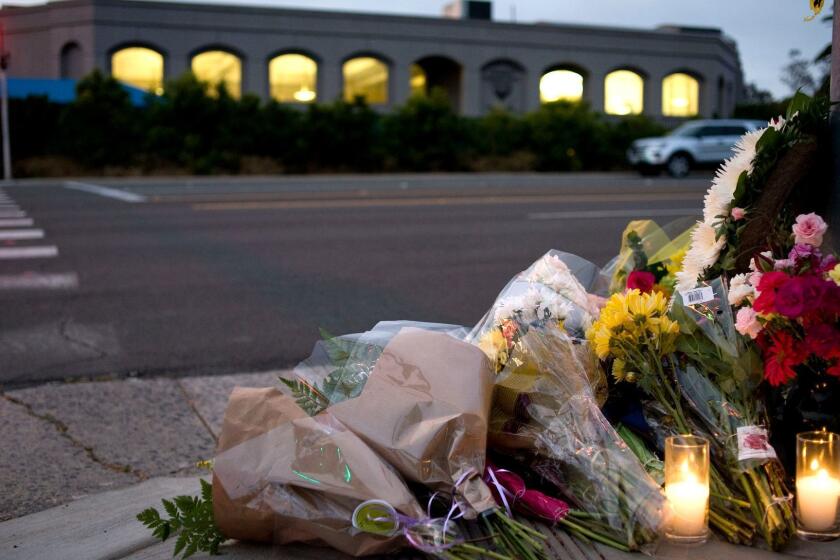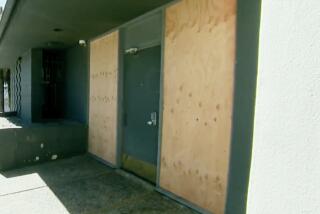‘There was chaos’: Witnesses in court hearing recall Poway synagogue shooting
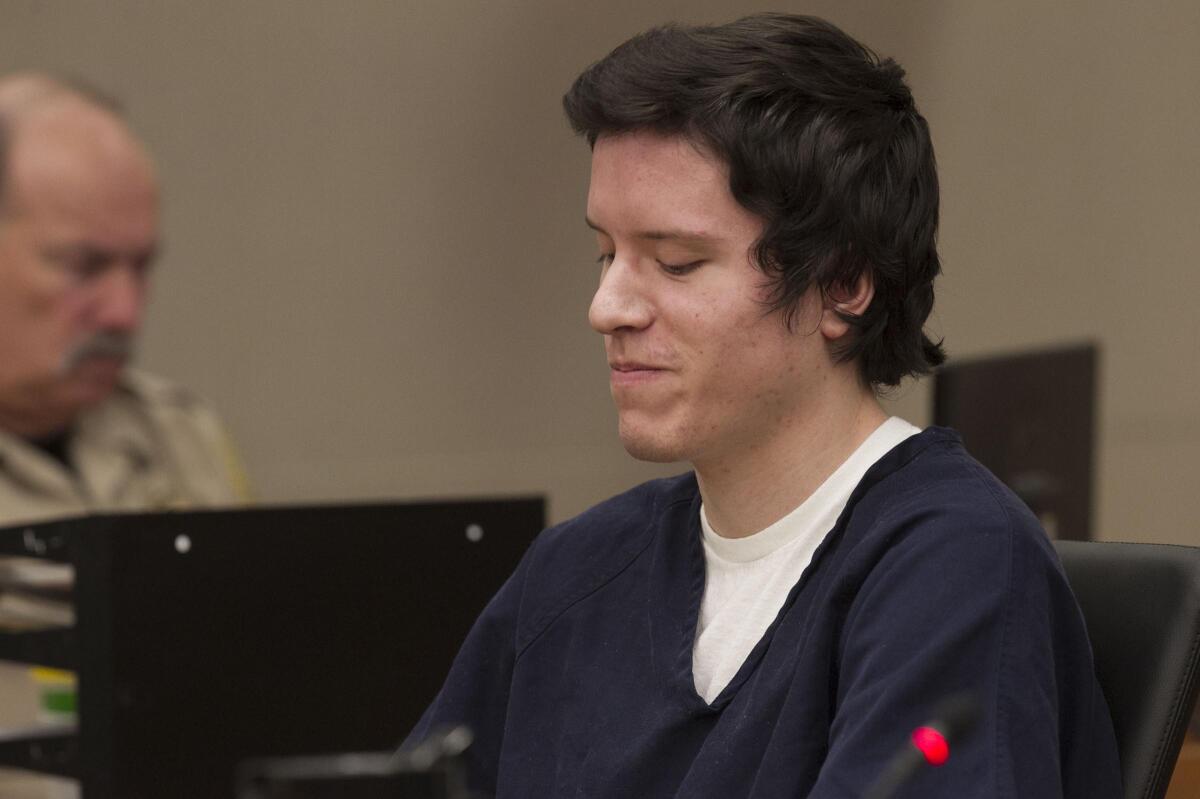
- Share via
SAN DIEGO — John Timothy Earnest didn’t hide his smirks as he sat in a San Diego courtroom on Thursday, watching surveillance video of Lori Gilbert-Kaye being shot down inside the lobby of a Poway synagogue.
Earnest also smiled as a synagogue congregant testified about running toward the shooter, screaming, “I’m going to kill you!” and seeing the gunman “with a look of astonishment or fear” turn and run.
Earnest, 20, is facing one count of murder and three counts of attempted murder in the shootings at Chabad of Poway on April 27. He also faces an arson charge related to an Escondido mosque fire in March, when several people who were sleeping inside escaped unharmed.
A preliminary hearing opened Thursday in Superior Court for Presiding Judge Peter Deddeh to listen to the evidence and decide whether it is sufficient to hold Earnest for trial. The hearing was expected to resume Friday with a final witness, a man who was wounded at the synagogue.
Authorities believe the shootings were prompted by Earnest’s hatred of Jews, as expressed in an online “open letter.” In the letter, he said he made up his mind to commit the shooting after 51 people were killed and 49 injured in a March 15 shooting by a suspected white-supremacist at a New Zealand mosque.
In the days after the shooting at the Chabad of Poway in April, here are some steps that investigators took, according to 300 pages of records.
At a lunch break in the hearing, Earnest turned partly toward spectators and made a “hang-loose” gesture with one hand, thumb and little finger extended. It wasn’t clear whom he was looking at, but family members of the woman killed at the synagogue were in court.
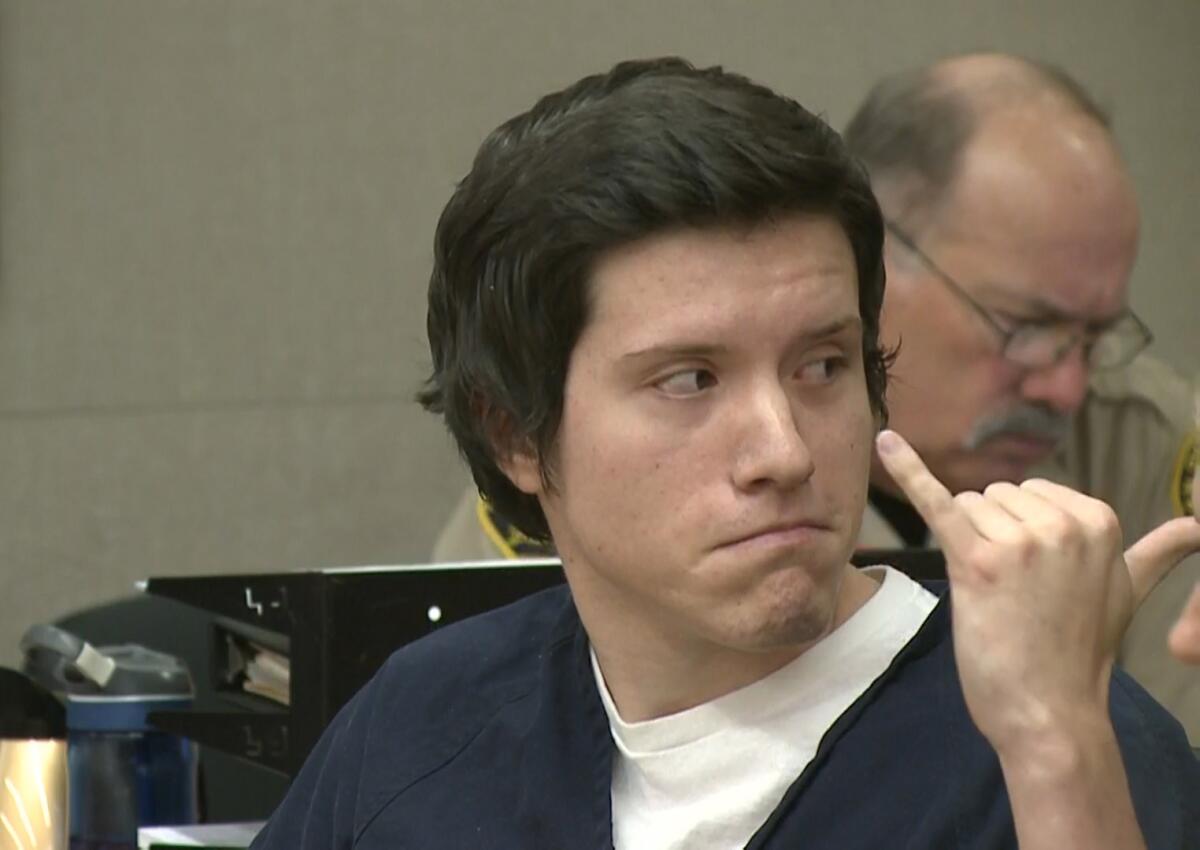
Gilbert-Kaye, 60, died after being shot twice from the back, according to a San Diego County deputy medical examiner. Dr. Steven Campman testified that the two rounds caused fatal internal injuries, hitting an artery, her lungs, spine and ribs.
Surveillance camera footage of the lobby of the synagogue viewed in court showed a man firing an assault-style rifle from just outside the front door, hitting Gilbert-Kaye as she turned to run. She fell at the doors to the sanctuary.
Rabbi Yisroel Goldstein, seen in the video walking through the lobby, was wounded in each hand and lost a finger as a result of the shooting.
Congregant Almog Peretz and his 8-year-old niece, Noya Dahan, also were wounded.

A prosecutor said Peretz would testify on Friday but his niece and the rabbi would not.
Oscar Stewart testified that he had been attending Chabad of Poway for about six months before the April shooting. That day, he was standing in a back corner of the sanctuary as readings from the Torah and blessings were being given to celebrate the last day of Passover. About 45 to 50 people were inside, he said.
Then, he said, he heard four gunshots. His first instinct was to run away, but within seconds he decided to head toward it.
New federal charges were filed Tuesday against a man accused of opening fire in a Southern California synagogue, killing one person and wounding three others.
“I saw men running toward the exit door, people were falling over each other. There was chaos,” Stewart recalled. “I heard screaming from the women’s side, and people yelling, ‘Get down!’”
Stewart noted that men and women are separated in the synagogue, sitting on opposite sides with a partition between them.
He said he heard more shots as he ran to the lobby. He saw two muzzle flashes, the gunman’s final shots. He didn’t know where the rounds went, he said. “I was focused on the rifle,” Stewart told Deputy Dist. Atty. Leonard Trinh.
Stewart locked eyes briefly with Earnest a few times while testifying.
Stewart said he served in the Navy during the 1991 Persian Gulf War and enlisted in the Army in 2001, taking part in the later invasion of Iraq and seeing further duty in a subsequent campaign. He estimated he had been in at least 20 shootouts and saw people die while in combat.
He said he saw the synagogue gunman lower his rifle and try to manipulate something.
“I believe he was out of ammunition and he was trying to reload,” Stewart said. “I told him I was going to kill him. I yelled it; I used profanities. I kept screaming at him. I was trying to throw him off.”
He recalled that the shooter turned and ran toward his car, a gray Honda Civic parked across the street. Stewart ran up to the car and punched it, planning to pull the gunman out of the driver’s seat.
Then, however, he said he heard a man behind him yell, “Fall back, I have a gun!” Stewart stood behind the Civic as Jonathan Morales, an off-duty Border Patrol officer who is a member of the congregation, opened fire on the car.
The rabbi was celebrating the last day of Passover with his congregants at Chabad of Poway when a gunman in a green army-style vest, armed with a semiautomatic weapon, burst in and began shooting.
The Civic made a U-turn and headed for Rancho Bernardo Road while Stewart tried to memorize the license plate number, he said.
Prosecutors played 911 recordings of a man who identified himself as John Earnest and told dispatchers, “I just shot up a synagogue.”
The first call was to the California Highway Patrol dispatch center about 11:20 a.m. The dispatcher repeatedly asked Earnest for his location, whether he had a weapon and why he “did it.”
“I’m just trying to defend my nation from the Jewish people,” the caller said. “They’re destroying my people.”
The call was transferred to a San Diego County Sheriff’s Department dispatcher, who also asked for Earnest’s location. Earnest can be heard giving a sigh at one point when he repeated that he was at West Bernardo Center Drive and Rancho Bernardo Road. He tells the dispatcher he has a gun, “but I’m not going to use it.”
He says, “I opened fire in a synagogue. I think I killed some people. Some man returned fire with a pistol. I got in my car and drove away.”
The man suspected of killing a woman in a shooting at a San Diego County synagogue pleaded not guilty to federal hate-crime charges Tuesday.
He also sounded impatient at one point, telling the dispatcher, “I’m stopped. I’ve been here for a long-ass time.”
San Diego police Officer Jonathan Wiese testified that he heard a radio dispatch regarding shots fired in Rancho Bernardo. He tuned into the Poway sheriff’s frequency and heard more details on the shooting, so he raced off in that direction, at up to 130 mph, and reached Earnest’s car in about 10 minutes.
He said he t ordered the driver out of the Civic, which was stopped in a traffic lane. The driver got out and followed orders to get on the ground. Wiese said he handcuffed the driver, Earnest, and saw a rifle on the car front seat.
A sheriff’s evidence technician testified that she noted a bullet hole above the driver’s window of Earnest’s car, presumably from a round fired by the off-duty Border Patrol officer.
On the front seat with the rifle were five magazines holding 10 cartridges apiece, as well as a tactical helmet with a Go-Pro camera mounted on it, a green duffel bag and a manual for the rifle.
Escondido police Det. William Havens testified that he investigated a fire at the Dar-ul-Arqam mosque in Escondido on March 24, about 3:20 a.m. An outside wall was scorched in several places, and Havens said he noticed a chemical odor.
Seven people had been sleeping inside but got out safely and used a fire extinguisher to put out the flames. Havens said security camera video on nearby shops showed a man get out of a dark Honda Civic with a gas can, enter a gate to the mosque, then return to the car and drive away. One video showed a flash of light and smoke before the man returned to his car.
Graffiti spray-painted in the mosque parking lot expressed support for the gunman in the New Zealand mosque shootings.
When detectives found an “open letter” in a folder on Earnest’s home computer, it contained a reference to the New Zealand attacks, the Escondido fire and Earnest’s intention to kill Jews.
That was the same day Earnest bought his Smith & Wesson AR-15 rifle, cartridges and other items from San Diego Guns in Grantville on April 13, according to a sales receipt shown in court. The gun cost $729.99.
A forensic evidence technician with the Sheriff’s Department said an orange state hunting license was found in Earnest’s wallet, good from July 1 this year through June 30 next year.
In California, no one under age 21 may purchase a gun unless they have a valid hunting license. Earnest’s hunting license would not have been valid yet when he bought the rifle in April.
More to Read
Sign up for Essential California
The most important California stories and recommendations in your inbox every morning.
You may occasionally receive promotional content from the Los Angeles Times.

